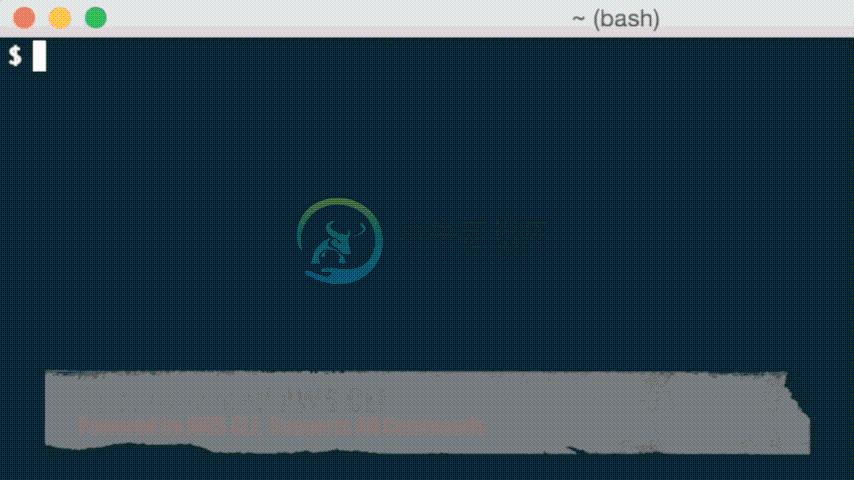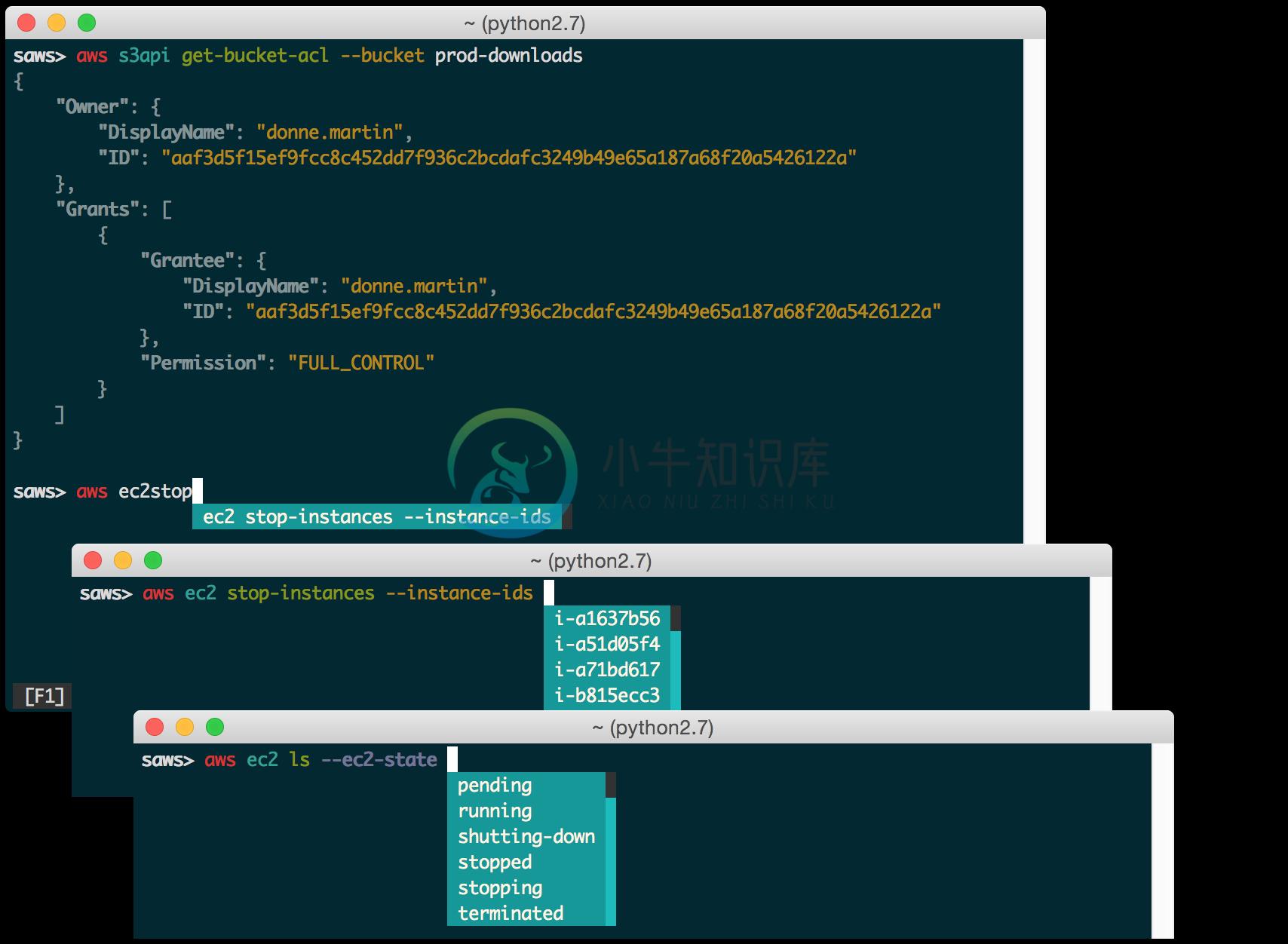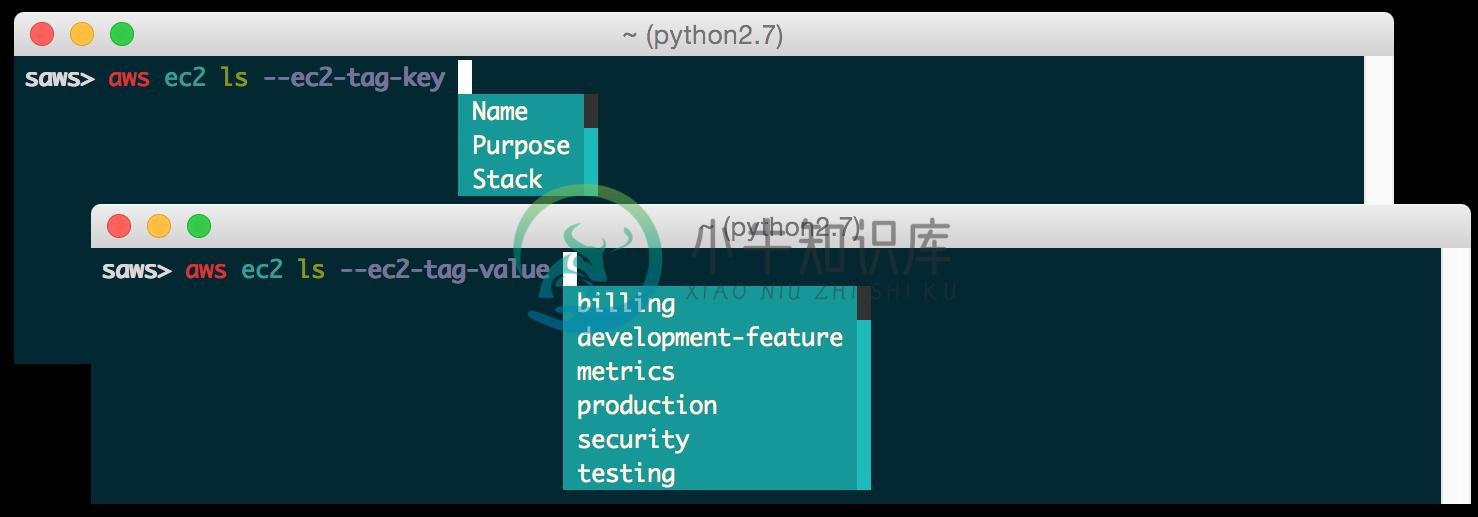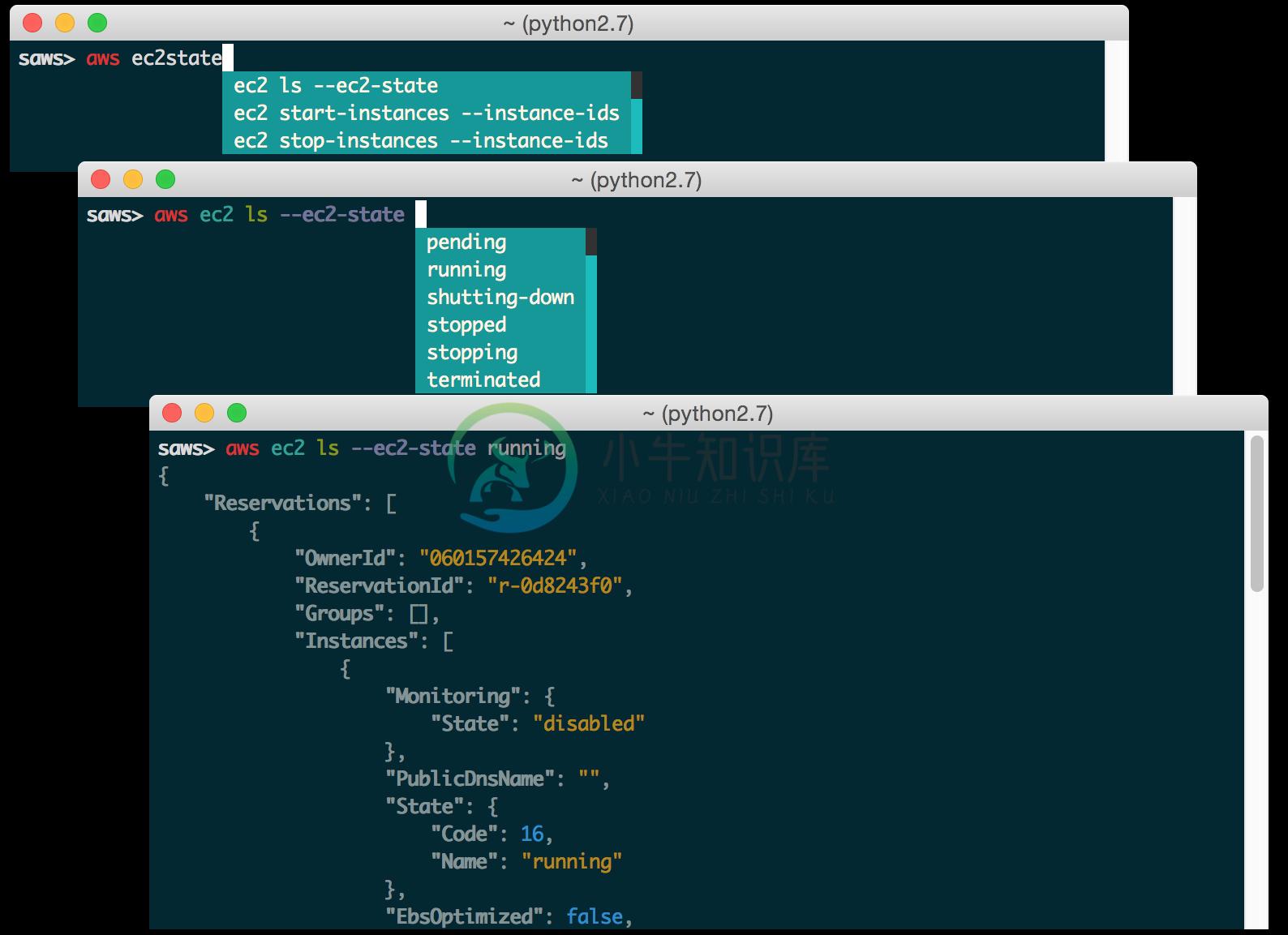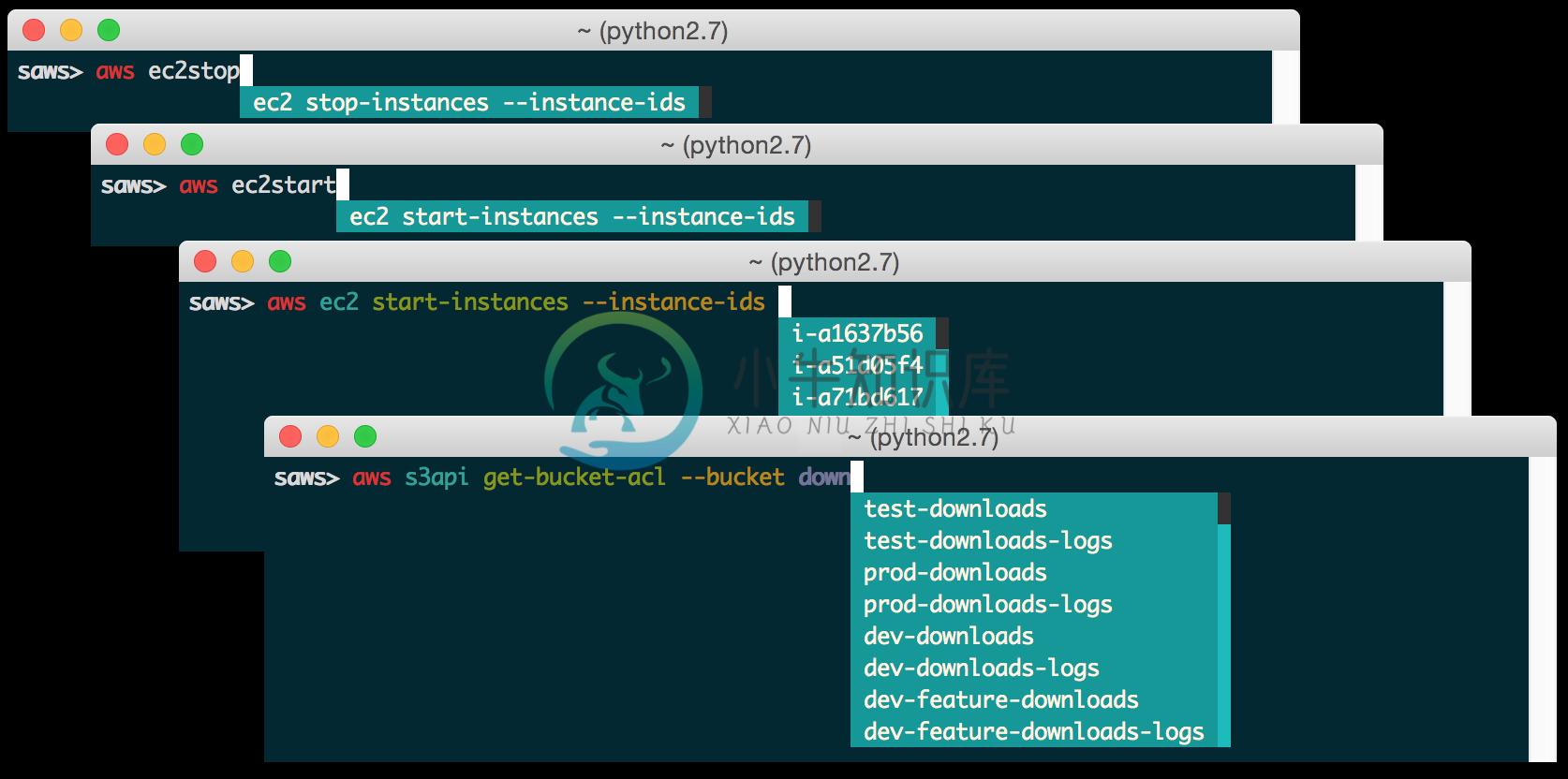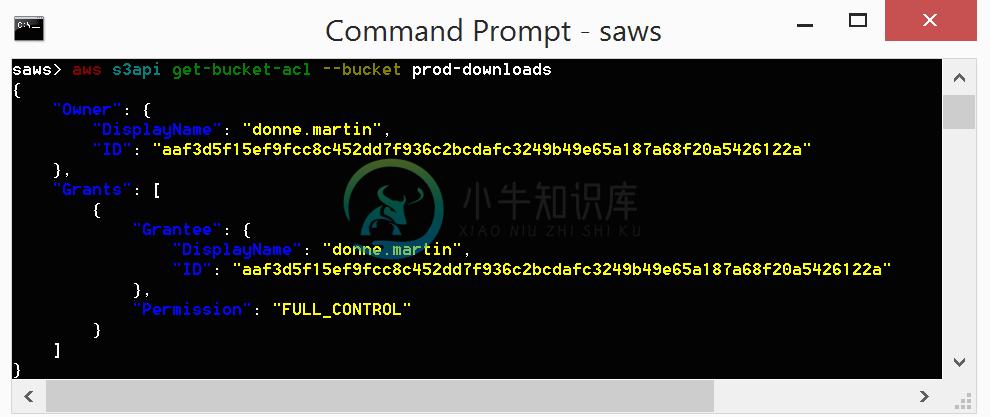SAWS
Motivation
AWS CLI
Although the AWS CLI is a great resource to manage your AWS-powered services, it's tough to remember usage of:
- 70+ top-level commands
- 2000+ subcommands
- Countless command-specific options
- Resources such as instance tags and buckets
SAWS: A Supercharged AWS CLI
SAWS aims to supercharge the AWS CLI with features focusing on:
- Improving ease-of-use
- Increasing productivity
Under the hood, SAWS is powered by the AWS CLI and supports the same commands and command structure.
SAWS and AWS CLI Usage:
aws <command> <subcommand> [parameters] [options]
SAWS features:
- Auto-completion of:
- Commands
- Subcommands
- Options
- Auto-completion of resources:
- Bucket names
- Instance ids
- Instance tags
- More coming soon!
- Customizable shortcuts
- Fuzzy completion of resources and shortcuts
- Fish-style auto-suggestions
- Syntax and output highlighting
- Execution of shell commands
- Command history
- Contextual help
- Toolbar options
SAWS is available for Mac, Linux, Unix, and Windows.
Index
Features
- Syntax and Output Highlighting
- Auto-Completion of Commands, Subcommands, and Options
- Auto-Completion of AWS Resources
- Customizable Shortcuts
- Fuzzy Resource and Shortcut Completion
- Fish-Style Auto-Suggestions
- Executing Shell Commands
- Command History
- Contextual Help
- Toolbar Options
- Windows Support
Installation and Tests
Misc
Syntax and Output Highlighting
You can control which theme to load for syntax highlighting by updating your ~/.sawsrc file:
# Visual theme. Possible values: manni, igor, xcode, vim, autumn, vs, rrt,
# native, perldoc, borland, tango, emacs, friendly, monokai, paraiso-dark,
# colorful, murphy, bw, pastie, paraiso-light, trac, default, fruity
theme = vim
Auto-Completion of Commands, Subcommands, and Options
SAWS provides smart autocompletion as you type. Entering the following command will interactively list and auto-complete all subcommands specific only to ec2:
aws ec2
Auto-Completion of AWS Resources
In addition to the default commands, subcommands, and options the AWS CLI provides, SAWS supports auto-completion of your AWS resources. Currently, bucket names, instance ids, and instance tags are included, with additional support for more resources under development.
S3 Buckets
Option for s3api:
--bucket
Sample Usage:
aws s3api get-bucket-acl --bucket
Syntax for s3:
s3://
Sample Usage:
aws s3 ls s3://
Note: The example below demonstrates the use of fuzzy resource completion:
EC2 Instance Ids
Option for ec2:
--instance-ids
Sample Usage:
aws ec2 describe-instances --instance-ids
aws ec2 ls --instance-ids
Note: The ls command demonstrates the use of customizable shortcuts:
EC2 Instance Tags
Option for ec2:
--ec2-tag-key
--ec2-tag-value
Sample Usage:
aws ec2 ls --ec2-tag-key
aws ec2 ls --ec2-tag-value
Tags support wildcards with the * character.
Note: ls, --ec2-tag-value, and --ec2-tag-key demonstrate the use of customizable shortcuts:
TODO: Add More Resources
Feel free to submit an issue or a pull request if you'd like support for additional resources.
Customizable Shortcuts
The ~/.saws.shortcuts file contains shortcuts that you can modify. It comes pre-populated with several handy shortcuts out of the box. You can combine shortcuts with fuzzy completion for even less keystrokes. Below are a few examples.
List all EC2 instances:
aws ec2 ls
List all running EC2 instances:
aws ec2 ls --ec2-state running # fuzzy shortcut: aws ecstate
List all EC2 instances with a matching tag (supports wildcards *):
aws ec2 ls --ec2-tag-key # fuzzy shortcut: aws ectagk
aws ec2 ls --ec2-tag-value # fuzzy shortcut: aws ectagv
List EC2 instance with matching id:
aws ec2 ls --instance-ids # fuzzy shortcut: aws eclsi
List all DynamoDB tables:
aws dynamodb ls # fuzzy shortcut: aws dls
List all EMR clusters:
aws emr ls # fuzzy shortcut: aws emls
Add/remove/modify shortcuts in your ~/.saws.shortcuts file to suit your needs.
Feel free to submit:
- An issue to request additional shortcuts
- A pull request if you'd like to share your shortcuts (see contributing guidelines)
Fuzzy Resource and Shortcut Completion
To toggle fuzzy completion of AWS resources and shortcuts, use F3 key.
Sample fuzzy shortcuts to start and stop EC2 instances:
aws ecstop
aws ecstart
Note: Fuzzy completion currently only works with AWS resources and shortcuts.
Fish-Style Auto-Suggestions
SAWS supports Fish-style auto-suggestions. Use the right arrow key to complete a suggestion.
Executing Shell Commands
SAWS allows you to execute shell commands from the saws> prompt.
Command History
SAWS keeps track of commands you enter and stores them in ~/.saws-history. Use the up and down arrow keys to cycle through the command history.
Contextual Help
SAWS supports contextual command line help and contextual web docs.
Contextual Command Line Help
The help command is powered by the AWS CLI and outputs help within the command line.
Usage:
aws <command> <subcommand> help
Contextual Web Docs
Sometimes you're not quite sure what specific command/subcommand/option combination you need to use. In such cases, browsing through several combinations with the help command line is cumbersome versus browsing the online AWS CLI docs through a web browser.
SAWS supports contextual web docs with the docs command or the F9 key. SAWS will display the web docs specific to the currently entered command and subcommand.
Usage:
aws <command> <subcommand> docs
Toolbar Options
SAWS supports a number of toolbar options:
F2toggles output syntax highlightingF3toggles fuzzy completion of AWS resources and shortcutsF4toggles completion of shortcutsF5refreshes resources for auto-completionF9displays the contextual web docsF10orcontrol dexitsSAWS
Windows Support
SAWS has been tested on Windows 7 and Windows 10.
On Windows, the .sawsrc file can be found in %userprofile%. For example:
C:\Users\dmartin\.sawsrc
Although you can use the standard Windows command prompt, you'll probably have a better experience with either cmder or conemu.
Installation
Pip Installation
SAWS is hosted on PyPI. The following command will install SAWS along with dependencies such as the AWS CLI:
$ pip install saws
You can also install the latest SAWS from GitHub source which can contain changes not yet pushed to PyPI:
$ pip install git+https://github.com/donnemartin/saws.git
If you are not installing in a virtualenv, run with sudo:
$ sudo pip install saws
Once installed, start SAWS:
$ saws
Virtual Environment and Docker Installation
It is recommended that you install Python packages in a virtualenv to avoid potential issues with dependencies or permissions.
To view SAWS virtualenv and Docker installation instructions, click here.
Mac OS X 10.11 El Capitan Users
There is a known issue with Apple and its included python package dependencies (more info at https://github.com/pypa/pip/issues/3165). We are investigating ways to fix this issue but in the meantime, to install saws, you can run:
$ sudo pip install saws --upgrade --ignore-installed six
AWS Credentials and Named Profiles
Configure your credentials with the AWS CLI:
$ aws configure
If you'd like to use a specific named profile with SAWS, run the following commands on OS X, Linux, or Unix:
$ export AWS_DEFAULT_PROFILE=user1
$ saws
Or as a one-liner:
$ AWS_DEFAULT_PROFILE=user1 saws
Windows users can run the following commands:
> set AWS_DEFAULT_PROFILE=user1
> saws
Command line options for starting SAWS with a specific profile are under development. For more details on how to install and configure the AWS CLI, refer to the following documentation.
Supported Python Versions
- Python 2.6
- Python 2.7
- Python 3.3
- Python 3.4
- Pypy
Light testing indicates that SAWS also seems to be compatible with Python 3.5.
Pypy3 is not supported due to lack of support from boto.
Supported Platforms
- Mac OS X
- Tested on OS X 10.10
- Linux, Unix
- Tested on Ubuntu 14.04 LTS
- Windows
- Tested on Windows 7 and 10
Developer Installation
If you're interested in contributing to SAWS, run the following commands:
$ git clone https://github.com/donnemartin/saws.git
$ pip install -e .
$ pip install -r requirements-dev.txt
$ saws
Continuous Integration
Continuous integration details are available on Travis CI.
Dependencies Management
Dependencies management details are available on Gemnasium.
Unit Tests and Code Coverage
Run unit tests in your active Python environment:
$ python tests/run_tests.py
Run unit tests with tox on multiple Python environments:
$ tox
Documentation
Source code documentation is available on Readthedocs.org.
Run the following to build the docs:
$ scripts/update_docs.sh
Contributing
Contributions are welcome!
Review the Contributing Guidelines for details on how to:
- Submit issues
- Submit pull requests
Credits
- AWS CLI by AWS for powering
SAWSunder the hood - Python Prompt Toolkit by jonathanslenders for simplifying the creation of
SAWS - Wharfee by j-bennet for inspiring the creation of
SAWSand for some handy utility functions
Contact Info
Feel free to contact me to discuss any issues, questions, or comments.
- Email: donne.martin@gmail.com
- Twitter: donne_martin
- GitHub: donnemartin
- LinkedIn: donnemartin
- Website: donnemartin.com
License
I am providing code and resources in this repository to you under an open source license. Because this is my personal repository, the license you receive to my code and resources is from me and not my employer (Facebook).
Copyright 2015 Donne Martin
Licensed under the Apache License, Version 2.0 (the "License");
you may not use this file except in compliance with the License.
You may obtain a copy of the License at
http://www.apache.org/licenses/LICENSE-2.0
Unless required by applicable law or agreed to in writing, software
distributed under the License is distributed on an "AS IS" BASIS,
WITHOUT WARRANTIES OR CONDITIONS OF ANY KIND, either express or implied.
See the License for the specific language governing permissions and
limitations under the License.
-
问题内容: 我经常不得不调试编写的Java代码,以便有一个接口和该接口的一个实现。 例如,将有一个接口Foo,其中有一个名为FooImpl的实现。在下面的代码中,如果我按住ctrl键单击doThings,则当我实际要转到FooImpl.java来查看实现时,它将跳至Foo.java。 当我结束界面时,必须使用ctrl-shift-r打开FooImpl。如果我可以按一下ctrl- alt并单击doT
-
问题内容: 首先,我不是要在这里发动战争。我非常了解Jersey,但是很少使用httpclient。 jersey-client和Apache的httpclient之间的主要区别是什么?在哪些方面比另一方面更好?哪里有比较好的图表?较大的文件(例如2048 MB)中,哪一个效果更好? 非常感谢您的评论! 问题答案: 这两件事可能不应该直接比较。Jersey是REST客户端,具有完整的JAX-RS实
-
问题内容: 我的应用程序中有两个表。左表就像一个列表。单击左表将打开一个右表,其中包含基于我单击左表的字段的值。 现在的问题是,如果我在右表中编辑一个单元格,而不按Enter键并单击左表中的新项目,则所有表中的特定单元格都处于可编辑模式。以及所有表格的单元格值。 我该如何解决这个问题? 问题答案: 不能完全肯定,我明白你的感受VS你所期望的,但表的默认行为是有点出乎意料的是,当焦点转到表外的某个地
-
问题内容: 如何使用google-api-java-client解析用户Google日历中事件的开始和结束时间? 从Google代码安装此示例android项目后,我可以进入Google日历并解析一些信息(例如所有日历,事件名称,发布时间和摘要),但是我无法终生获取事件的开始和结束时间。 我对代码的理解是这样的。 在主要活动类(CalendarAndroidSample.java)内,这是获取我每
-
问题内容: 我正在为小型LibGDX驱动的游戏编写服务器端代码,偶然发现了一个问题。每次尝试使用任何方法时,都会遇到。 显然这是因为我没有实现ApplicationListener,所以LibGDX尚未初始化。 有没有办法以无头/ CLI方式初始化LibGDX?我需要能够在服务器端加载TiledMap对象。 com.esotericsoftware.kryonet.Server $ 1.recei
-
问题内容: 我们正在尝试将声音集成到我们的一个项目中,我的团队成员没有收到此错误,而是在两台不同的机器上收到了此错误。 堆栈跟踪: 码: 我们从domainController调用此类 有谁知道如何解决此异常?我尝试重新安装编辑器软件(Eclipse),但无济于事。 预先感谢分配。 编辑 我们只是尝试切换声音文件。我们尝试使用较小的文件运行它。现在可以使用,但是一旦切换回较大的.wav文件(10
-
问题内容: 我在Web应用程序中使用Jersey 2.13检索数据异步。在某些情况下,请求需要一段时间(即执行复杂报告时,即EE)才能将响应返回给客户端。 当客户端不等待异步响应(离开页面,关闭浏览器等)时,将抛出ClientAbortException。此行为是预期的,但它使堆栈跟踪淹没了我的日志文件,因为在响应返回之前被取消的每个单个异步请求都会打印堆栈跟踪。 堆栈跟踪如下所示: 我也正在使用
-
问题内容: 我在Netbeans中的Java中创建了一个表,并在其中填充了一些数据。现在,我想在单击该单元格时在与行中的特定列相对应的文本区域中显示一些详细信息。如何使用事件侦听器找出单元用户已单击的位置。 问题答案: 找到点击事件的位置并获取要搜索的单元格:


